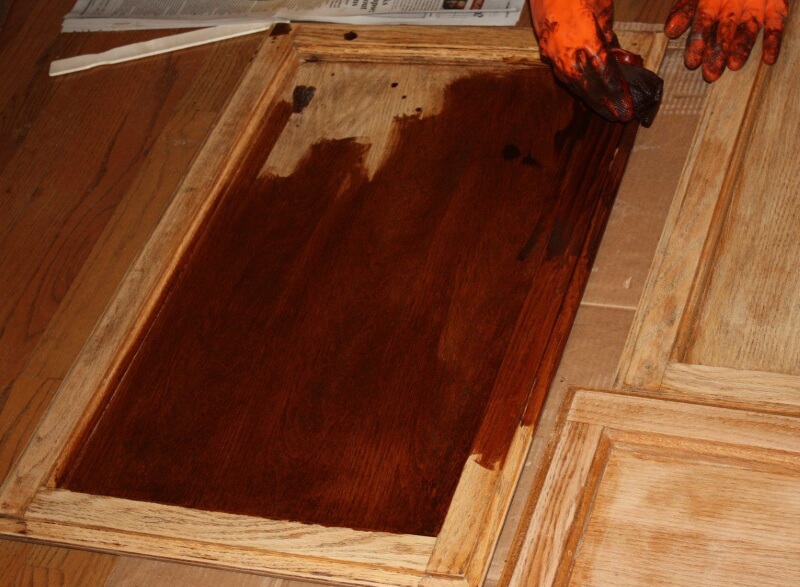
Refinishing kitchen and bathroom cabinets is a transformative process that can breathe new life into these essential spaces. It involves restoring the appearance and quality of the cabinets by stripping off the existing finish, repairing any damage, and applying a fresh coat of paint or stain. Below we explore a little bit of the process and work required to refinish cabinets, highlighting the importance of doing so to maintain the quality of the material and how it can add value to your home. It’s not an easy task to undertake yourself, so you may want to give us a call to help. If you choose to give it a shot, consider the following information.
To refinish cabinets, you will need several types of materials and assorted tools & equipment. Firstly, you will require sandpaper or a sanding block to remove the existing finish and create a smooth surface. A paint or stain stripper may be necessary for stubborn finishes. Next, you will need paint or stain of your choice, as well as brushes or sprayers to apply the new finish. Other essential items include a drop cloth or plastic sheeting to protect surrounding surfaces, painter’s tape for clean edges, and a screwdriver or drill to remove cabinet hardware. Lastly, you may need wood filler or putty to repair any imperfections before refinishing.
Refinishing cabinets typically begins with the preparation stage. This involves removing the doors, drawers, and hardware from the cabinets, ensuring a clean and accessible surface for the refinishing process. The next step is to strip the existing finish. Depending on the type of finish, this may involve using chemical strippers, sanding, or a combination of both. Stripping the old finish is crucial as it allows for a clean and smooth surface to work with.
After the cabinets have been stripped, any necessary repairs are made. This includes filling in cracks, dents, or holes with wood filler, and sanding the repaired areas to ensure a seamless and even surface. It’s important to address any structural issues or damage before moving forward to achieve the best results.
Once the cabinets are repaired and sanded, it’s time to apply the new finish. This can involve either painting or staining, depending on personal preference and the desired outcome. When painting, multiple coats of primer and paint are typically applied, with sanding in between to achieve a smooth and durable finish. Staining involves applying multiple coats of stain, allowing each coat to dry and sanding in between to achieve the desired depth and color. To protect the newly refinished cabinets, a clear topcoat or sealant is usually applied as a final step.
Refinishing kitchen and bathroom cabinets is an investment that offers several important benefits. Firstly, it allows you to maintain the quality of the material. Over time, cabinets can become worn, scratched, or discolored due to regular use and exposure to moisture and heat. Refinishing restores the appearance of the cabinets, making them look fresh and new again. By removing the old finish and applying a new one, you can effectively protect the wood or other material from further damage and prolong its lifespan.
Additionally, refinishing cabinets can significantly enhance the value and appeal of your home. The kitchen and bathroom are key areas that potential buyers often focus on when evaluating a property. Outdated or worn cabinets can detract from the overall aesthetic and make the space feel dated. By refinishing the cabinets, you can modernize the look of these rooms and create a more cohesive and visually appealing environment. This can have a positive impact on the perceived value of your home and increase its market appeal.
Furthermore, refinishing cabinets offers a cost-effective alternative to replacing them entirely. New cabinets can be expensive, and the process of removing and installing them can be time-consuming and disruptive. Refinishing allows you to achieve a similar transformation at a fraction of the cost and with less inconvenience. It’s a more sustainable option that minimizes waste and contributes to a more environmentally friendly approach to home improvement.
In conclusion, refinishing kitchen and bathroom cabinets involves a thorough process of stripping, repairing, and applying a new finish. This work is essential to maintain the quality of the material and restore the appearance of the cabinets. Refinishing not only extends the lifespan of the cabinets but also adds value to your home by enhancing its overall aesthetic appeal. It offers a cost-effective and sustainable alternative to cabinet replacement, allowing you to achieve a fresh and updated look without the expense and hassle of a full renovation.